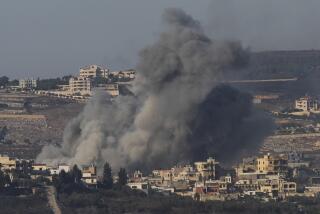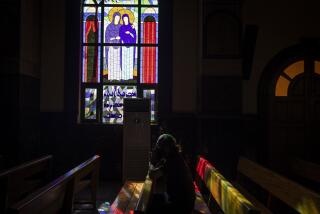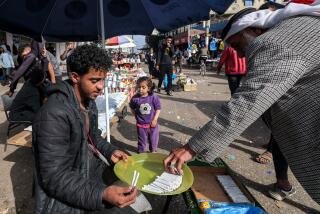A Forbidding Land of Drugs, Guns : Lebanon: Even residents of shell-shattered Beirut shun the Bekaa Valley, home to narcotics traders, guerrilla training camps and Syrian troops.
BAALBEK, Lebanon — In their violent, shell-shattered capital of Beirut, Lebanese think twice before traveling east to the Bekaa Valley. Whatever lies over the snowy ridges of the Lebanon Mountains is, Beirutis say, bad news.
The shady reputation has fallen hard on the long, bountiful valley where coastal Lebanese and foreign tourists once came for leisurely outings.
“This (word-of-mouth) advertising is killing us here in Baalbek,” complained a local cabbie.
However placid the valley seems, its bad name is understandable. Lying within a two-hour drive of Beirut, the area is deep into the production of narcotics, provides sanctuary for cells of foreign guerrillas and is laden with Syrian soldiers.
The 75-mile-long trough of the Bekaa stretches northeasterly through the length of Lebanon, bounded on the west by the 8,500-foot heights of the Lebanon Mountains and on the east by Syria’s Anti-Lebanon range. The valley floor is seldom wider than 10 miles and makes up most of the country’s arable land.
Lebanese legend holds that Noah’s Ark landed near the village of Tibnin in the southern Bekaa and that the biblical patriarch is buried near Zahlah, the valley’s largest city. Nearby stands the Caves de Ksara winery, the biggest in the Middle East, where bottles bear the legend: “Born in the land of Noah, the first biblical winegrower.”
The 130-year-old winery, founded by Jesuit priests, is still a major exporter, sending its Ksara label as far as Glendale, Calif. But in recent years, the hot cash crop in the Bekaa has been narcotics: hashish and opium.
And here in Baalbek, where camera-toting tourists once whiled away their afternoons in the Roman temples of ancient Heliopolis, the prominent visitors are now an estimated 1,000 or more Iranian Revolutionary Guards, dispatched by the late Ayatollah Ruhollah Khomeini at the start of the 1982 Israeli invasion of Lebanon. Khomeini termed Baalbek the jumping-off point for a new Islamic conquest of Jerusalem.
His guardsmen never came close. The easternmost of Israel’s three-pronged 1982 assault pushed into the southern Bekaa, rolling back Syrian forces, the Iranians’ protectors. Israeli warplanes, after knocking out most of Syria’s air force in furious dogfights over Beirut on the second day of the invasion, leveled the Syrian SAM-6 anti-aircraft positions in the Bekaa on the third day.
Today, however, the Bekaa remains firmly under control of the Syrian army, first sent into Lebanon as a peacekeeping force in 1976, the year after beleaguered Lebanon’s still-running civil war began. There is not a major crossroad in the Bekaa without a Syrian checkpoint, and the Syrians permit no local militias to establish one.
Most of the estimated 40,000 or more Syrian troops in Lebanon are based in the Bekaa. Their main base is at Majdel Aanjar, just off the Damascus-Beirut road.
“The Syrians know precisely what goes on in the valley,” said a Western diplomat in Damascus, the Syrian capital. “Nothing can escape that apparatus.”
That includes the reported proliferation over the last decade of camps of armed outsiders, from the Iranian Revolutionary Guards in their barracks near Baalbek to smaller groups that, according to Western intelligence officials, have trained elsewhere in the valley under Syrian protection. Some accounts have suggested that the Bekaa houses a sort of Olympic Village of foreign guerrilla teams.
Turkish authorities have accused the Syrians of providing Bekaa bases for guerrillas of the nationalist Kurdish Workers Party and the Armenian Secret Army for the Liberation of Armenia. U.S. intelligence officers say the terrorist Japanese Red Army operates out of Lebanon, and Middle East-based diplomats put them somewhere in the valley.
Syrian-supported Palestinian dissident forces are known to have bases in the southern Bekaa. According to an Israeli military spokesman in Jerusalem, an Israeli air strike in the Bekaa in March, 1989, one of several in the region in recent months, was directed at a base of Ahmed Jibril’s Popular Front for the Liberation of Palestine-General Command.
That Syrian-shielded group was pinpointed as the chief suspect in the December, 1988, bombing of Pan American Flight 103 over Lockerbie, Scotland.
According to Beirut press reports, some of the foreign guerrillas were established near the small town of Yanta, north of Rachaiya, in the southern Bekaa near the Syrian border. One report now puts the Armenian guerrillas outside Sidon, a southern Lebanese port.
“It’s our understanding that these groups are not situated in bases per se,” said the Damascus-based diplomat. “They don’t have barracks with guerrilla flags flying from a mast. More likely they are in some little village and get together to practice field-stripping rifles and that sort of thing.”
Nonetheless, their reported presence adds to the image of the Bekaa as an anything-goes area.
Here in Baalbek, where the presence is Iranian and where the Lebanese Shiite Muslim terrorist faction known as Hezbollah was nurtured under Iranian guidance, the foreign influence is bothersome but often mundane.
There is, for instance, no alcohol sold in the city, and the local women keep their heads covered in the Muslim fundamentalist style.
Baalbek’s three television stations also illustrate the situation: The commercial channel runs to foreign film programming, including some American movies, with Arabic subtitles. The Hezbollah station offers a heavy menu of religious programs in Arabic.
The third channel is run by the Iranians, with most shows broadcast in Persian, Iran’s language.
An 8-year-old boy named Mohammed said he can watch Tom and Jerry cartoons on the Iranian channel but misses some of the Persian nuances. His father tunes in on the Lebanon Broadcasting Co. (LBC) telecasts from Beirut. LBC is run by the right-wing Christian Lebanese Forces, and its ads promote whiskey, lingerie and other fast-lane products now largely absent from Baalbek.
Among the ruins of the Roman temples, for 25 cents admission, bearded Shiite youths and their chador-clad girlfriends stop in the shadows of the ancient columns for a moment of privacy from religious social strictures.
But everything is up to date in the Bekaa when it comes to narcotics. Opium poppies are planted in the spring, and there are no sectarian boundaries in the trade. Watered by the runoff from the Lebanon Mountains, the colorful poppies will cover the foothills later in the year.
Opium and the traditional Indian hemp--the cannabis variety that produces hashish, an oil that is usually smoked in a cigarette or pipe and is the long-favored narcotic of the Arab world--have made the farmers of the northern Bekaa rich. A narcotics agent based in Cyprus said the valley’s 1988 crop produced 5.5 tons of raw opium. But hashish is still the biggest moneymaker.
“It’s a wide-open trade out there in the valley,” the narcotics agent said. “No big deal.”
Here in the Bekaa itself, farmers say that hemp, for instance, is primarily grown by Shiites, processed in part by Maronite Christians and shipped out of the northern port of Tripoli by Sunni Muslims. And all along the way, the narcotics agent said, everybody takes a cut.
“By the time a load of heroin makes its way through all the militia roadblocks to a southern port, each militia assessing a tax, “ he noted, “the on-board delivery price has been driven up 100%.”
Why the burgeoning drug trade?
“Look,” the narcotics man explained. “Money is power in Lebanon. Money buys guns, and guns are power. It’s like gang warfare in L.A.”
Free-lance writer Raschka reported from the Bekaa Valley and Times staff writer Williams from Nicosia, Cyprus.
More to Read
Sign up for Essential California
The most important California stories and recommendations in your inbox every morning.
You may occasionally receive promotional content from the Los Angeles Times.









